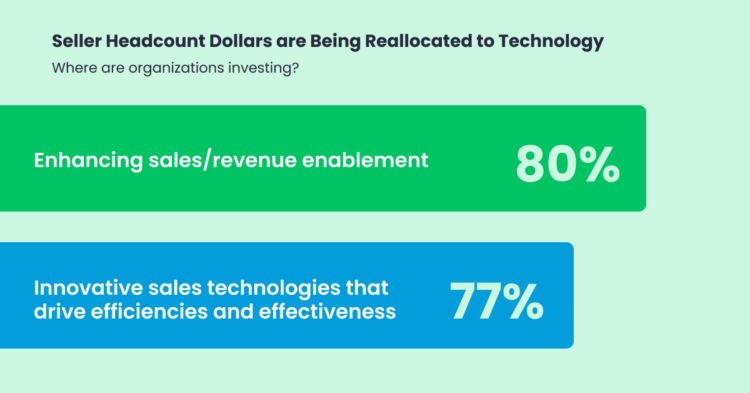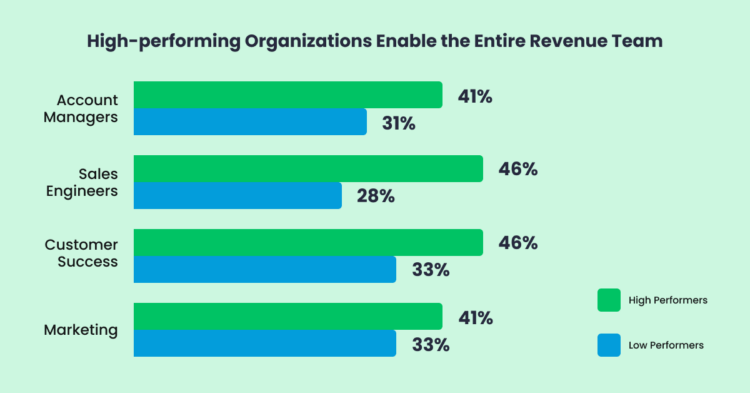At the dawn of the decade, there was an undeniable air of hope. Would this be the second coming of the roaring 20s? Would there be prosperity around every corner? Would investment in sales tech continue to grow at rapid speed?
The answer, unfortunately, would be a resounding no. The optimism that defined that time period was short-lived, snuffed out by steadily rising interest rates and inflation. Economic headwinds forced individuals to alter their habits and challenged companies to contain costs and grow more efficiently.
Business is changing, and revenue strategies should too
With purse strings tightening in the face of economic uncertainty, everyone is learning to do more with less. Back in the day, the answer to making more sales was simply to hire more salespeople. But today’s revenue leaders are realizing they can’t do things the way it’s always been done and efficiency needs to take priority.

To accomplish this, companies are already starting to divert their seller headcount dollars to technology. Instead of hiring a fleet of sales reps, companies are shifting towards smaller, more agile sales teams supported by a robust tech stack.
An impressive 67% of leaders indicate they are actively redeploying or planning to redeploy their sales headcount savings. These funds are being reallocated to two places: enhancing sales and revenue enablement (80%) and sales tech designed to boost efficiency (77%). From AI-driven process automation to intelligent content management, revenue leaders are turning to tech solutions to strengthen the impact of smaller teams and accomplish more than they could before.
Modern buyers require modern solutions
Economic conditions aren’t the only factors driving digital adoption. As millennials and Gen Z increasingly dominate the workforce, 80% of B2B buyer-seller interactions will occur in digital formats by 2025. At this point, one-third of all buyers desire a seller-free sales experience, and 44% of millennials prefer not to interact with a rep in a B2B purchase setting.
Clearly, buyers’ mindsets are shifting, and their desire for personalized, friction-free experiences borders on unanimous. B2B buyers now expect the purchase flow to mirror their B2C experiences, like those they find on Netflix or Amazon.
Legacy B2B sales techniques tend to be dry and formulaic. They are top-heavy with product education no longer necessary as buyers increasingly conduct their own research. B2C experiences feel far more dynamic, focused on delivering concise value propositions and transparent pricing to drive fast, simple decisions. They also deliver hyper-individualized experiences, with the ability to predict your preferences and then tailor recommendations accordingly.
For example, think of the last time you ordered a coffee using your favorite café’s mobile app. It was probably a visually engaging experience that put the major benefits upfront – seasonal flavor! limited-time promotion! spiced and autumnal! – and quickly shuffled you along to checkout. You didn’t have to wait for pricing to be revealed at the end, and you certainly didn’t have to sit through a slideshow about where they got their coffee beans.
These changes mark the sunsetting of traditional sales approaches. Today’s reps need more than just a rote toolbox of slides and pitches: they need a dynamic, data-backed trove of content that is proven to perform and packaged in a format that clients will enjoy. In short, they need revenue enablement.
What is revenue enablement?
To understand the concept of revenue enablement, let’s start by looking back on its predecessor: sales enablement. True to its name, this methodology is seller-focused and mostly unidirectional. Its goal is to place content into reps’ hands and train them to sell more effectively; its success is predominantly measured based on conversion rates.

Revenue enablement, on the other hand, takes a holistic approach to sales success. Instead of placing sellers at the top of the pyramid, this strategy empowers all client-facing teams to drive growth through cooperation.
From marketing to customer success, it unites departments by implementing shared tools, technologies, and data. Once established, these channels enable significantly more cross-pollination and transparency, rallying everyone around the same goals, processes, and insights.
According to recent data from Gartner, organizations that prioritize revenue enablement are 80% more likely to exceed their revenue growth targets. High-performing teams also consistently empower supporting sales roles more than low-performing teams: for example, 46% of high-performing companies empower their sales engineers, compared to just 28% of low-performing companies.
All signs point to revenue enablement being the next major frontier for sales excellence and organizational success. And in many ways, the revolution is already in full swing.
This is the first in a series of posts breaking down the research from our 2023 State of Revenue Enablement report. Stay tuned as we unpack more ways to prepare for revenue excellence in the year ahead.

Comments are closed.